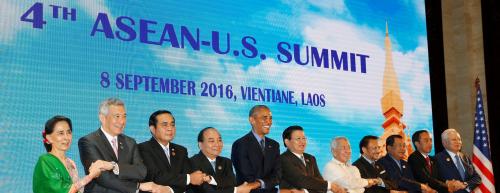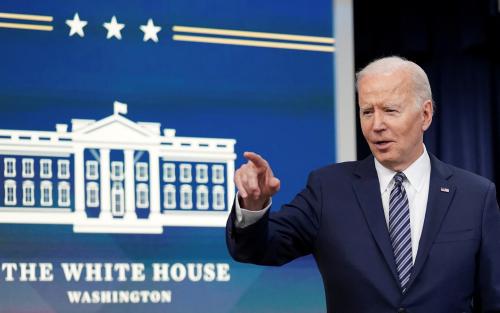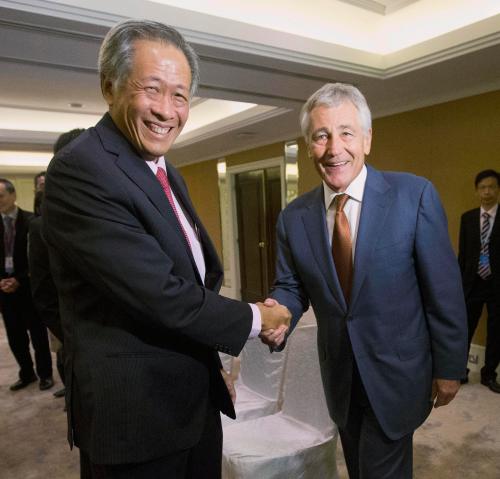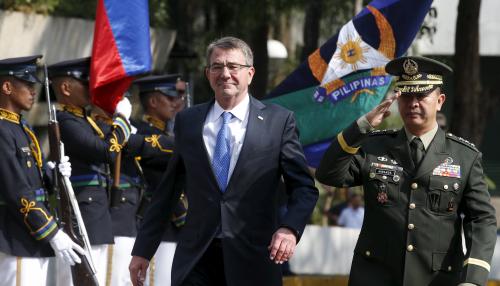Southeast Asia watchers have been waiting for President-elect Trump’s nomination for Secretary of State to complete the first sketch on what Mr. Trump’s policy towards the region might be. His pick of retired Marine General James Mattis as Secretary of Defense signaled a more robust approach to the South China Sea, though this might be somewhat at odds with what appears to be Mr. Trump’s own thoughts on the matter. The selection of retired Lt. Gen. Michael Thomas Flynn raised concerns about what his outspoken comments on Islam might mean for Southeast Asia’s majority- and even minority-Muslim countries. What does Mr. Trump’s latest pick add to the broad brushstrokes of this picture?
ExxonMobil chief executive Rex Tillerson is widely reported to be a strong proponent of free trade and close to President Putin of Russia. Some will no doubt regard his nomination as in keeping with an administration that envisions greater cooperation with Russia and a harder stance on China. But not a whole lot is known of Mr. Tillerson’s foreign policy views, especially as it pertains to Southeast Asia.
Mr. Tillerson likely has some familiarity with the region. ExxonMobil has a presence in Indonesia, Malaysia, Singapore, Thailand and Vietnam. ExxonMobil owns and operates the Singapore Refinery and Singapore Chemical Plant, which is the company’s largest integrated manufacturing site in the world. Mr. Tillerson has visited the city-state many times and met its prime minister.
Mr. Tillerson is also likely to be no stranger to the South China Sea dispute. In 2009, Exxon acquired the rights to explore off the coast of Vietnam. Hanoi considers this area part of its exclusive economic zone, but Beijing was unhappy with Exxon drilling there.
Still, Mr. Tillerson’s approach towards the region and how it will impact Mr. Trump’s largely inchoate thinking on it remains to be seen. While Mr. Trump has made putting “America first” the lodestar of his presidency, what this means in practice is unclear. Certainly, as a statement of objective it is neither novel nor objectionable that the United States puts its national interests first—this is what all countries seek to do.
U.S. INTERESTS IN SOUTHEAST ASIA
The Obama administration recognized Southeast Asia’s economic and strategic importance to the United States, and sought to broaden and deepen engagement with the region.
Some of the world’s busiest shipping lanes are located in the region. The 10 Association of Southeast Asian Nations (ASEAN) member states collectively comprise the third largest economy in Asia and the seventh largest in the world. The region is young and dynamic. More than 65 percent of its 632 million people are below the age of 35.
Sustained engagement with ASEAN increases Washington’s flexibility and influence.
Given rivalry between intra- and extra-regional powers, ASEAN stands at the heart of any viable security architecture in the wider region. Sustained engagement with ASEAN, which shares an interest in sustaining a rules-based order in the Asia-Pacific, increases Washington’s flexibility and influence. It also takes the edge off direct Sino-U.S. competition.
President Obama’s pivot to Asia was in fact a pivot to Southeast Asia. He leaves behind an enduring framework for engaging the region. Under Obama, the United States joined the East Asia Summit, which is hosted by ASEAN. It also set up the U.S.-ASEAN summit, which culminated, at least symbolically, in the Sunnylands meeting in the United States earlier this year.
Will a Trump administration, with Mr. Tillerson at its diplomatic helm, build on this strong foundation? Countries in Southeast Asia have three main concerns about the next four years.
WITHDRAWAL FROM THE TPP: A BLOW TO U.S. ECONOMIC AND STRATEGIC GOALS
First, U.S. withdrawal from the Trans Pacific Partnership (TPP). Four ASEAN countries (Brunei, Malaysia, Singapore and Vietnam) are members of the high-standard multilateral trade deal; others had expressed a desire to join. U.S. withdrawal will deal a blow to the agreement and to U.S. economic and strategic objectives. It will bring about a more empowered China.
Rejecting the TPP sends a signal that U.S. engagement with the region is narrow and, in any event, cannot be counted upon.
In Southeast Asia, economics is security. Rejecting the TPP sends a signal that U.S. engagement with the region is narrow and, in any event, cannot be counted upon. Many countries, including Malaysia and Vietnam, signed on to the TPP at considerable political cost, making the sting of a U.S. withdrawal all the greater. Regional newspapers are already reporting on new life being breathed into the Regional Cooperation Economic Partnership (RCEP), a trade deal China spearheaded in 2011 with considerably lower standards.
PIVOT TO PIROUETTE: REDUCED OR HAPHAZARD ENGAGEMENT WITH SOUTHEAST ASIA
ASEAN and its member states are also concerned about where the region will stand in the next administration’s list of priorities. Even a move from pivot to pirouette, that is, from focused to sporadic engagement, will hurt U.S. interests.
Veteran observers of the region maintain that Mr. Trump is likely to have little patience for ASEAN. It is associated more with droning meetings and doddering processes, than immediate and tangible rewards. Will Mr. Tillerson’s background in the oil industry, with its decades-long horizons before a return on investment, display greater equanimity?
Further, there are questions over the extent to which a Trump administration will countenance the simultaneous balancing and hedging that almost all ASEAN countries, including claimants in the South China Sea, undertake. The current administration may not like it, but understands that it is to be expected from China’s smaller neighbors. The avoidance of hard coalitions also helps to decrease the propensity for conflict.
At the end of the day, the extent of balancing and hedging that takes place depends on demonstrable U.S. commitment and Chinese behavior. As a rising and more assertive China heightens anxieties in Southeast Asia, countries are thinking about how best to position themselves. Neglecting the region will hurt the United States’ position and standing.
WEAK OR INEFFECTUAL DEFENSE OF INTERESTS AND PRINCIPLES: THE SOUTH CHINA SEA AS LITMUS TEST
The South China Sea is an important litmus test of U.S. commitment. Many countries in Southeast Asia are worried about a weak or ineffectual defense of interests and principles, though some are more vocal than others.
Mr. Trump has done little to allay anxieties. He suggested that he would use trade as a tool to get the Chinese to stop “ambitious” behavior that “totally disregard[s]” the United States. The last thing the region wants is a trade war.
At the same time, Mr. Trump appeared to distance the United States from the issue by stating that other countries are affected “far greater” and the South China Sea is “very far away”.
His words buy into Beijing’s narrative that the dispute only concerns claimants. Yet, non-claimants, including the United States, have critical interests in the peaceful settlement of disputes, adherence to the rule of law, and freedom of navigation. The dispute and how it plays out also sets the tone for the broader Sino-U.S. relationship and whether might or right governs relations between states.
Mr. Trump’s statement that China has “already built” in the South China Sea also appears to too readily concede the strategic landscape. The battle for the South China Sea is one of peacetime control over its waters and the airspace above them. It will be won or lost over responses to Beijing’s “grey zone” activities and creeping assertions of control over wide expanses of water and air.
The president-elect’s policy advisers have boldly claimed that a Trump administration will increase the navy from the current 274 ships to 350 ships. But more ships do not, in and of themselves, a strategy make (though it will be a boost to the defense industry). It still leaves open the question of where and for what purposes these ships will be deployed.
In this respect, General Mattis will be a trusted hand. In 2015, he gave testimony before the Senate Armed Services Committee questioning if the U.S. shipbuilding budget was sufficient, and stating that while efforts in the Pacific to keep positive relations with China are “well and good”, “these efforts must be paralleled by a policy to build the counterbalance if China continues to expand its bullying role in the South China Sea and elsewhere.” He emphasized both diplomacy and the credible threat of force in calling for the counterbalance to “deny China veto power over territorial, security and economic conditions in the Pacific, [thereby] building support for our diplomatic efforts to maintain stability and economic prosperity so critical to our economy.”
Regular assertions of maritime rights vested under international law will limit the extent of control China asserts from the features it occupies. This would not be a militarization of the region, nor a use of force, as Beijing claims. Indeed, failure to exercise these rights risks their loss in law and in practice.
The United States can also dissuade further activism by clearly communicating U.S. interests in the South China Sea. How the dispute pans out will affect Sino-U.S. relations and, more broadly, whether might or right governs relations between states.
Contrary to Mr. Trump’s claims, predictability in international relations is not always a bad thing. Privately communicating behavior which will be considered unacceptable will help to deter such conduct.
WHAT’S AT STAKE: THE STRATEGIC LANDSCAPE IN ASIA
If the United States withdraws from the TPP, neglects ASEAN and its member states, and is weak or ineffectual in its defense of interests and principles, this feeds into the Chinese narrative of an unreliable America, and could fundamentally alter the strategic landscape in Asia.
Some analysts argue that institutional checks and balances in the United States will limit the damage a president Trump can do. Yet, a stable and prosperous world-order based on respect for international law must also be about creating positive conditions for peace and prosperity. If the United States wants to affect the strategic evolution of Asia, it cannot come and go.
The next administration must engage Southeast Asia early on to assuage anxiety and put the relationship on a surer footing.
The next administration must engage Southeast Asia early on to assuage anxiety and put the relationship on a surer footing. It must also ensure that engagement is broad, deep and consistent. If the United States must withdraw from the TPP, it should first at least work out and signal the broad outline of what its presence means for the region both economically and in the security realm.
Engagement must be based on respect for the countries of Southeast Asia. This means understanding their legitimate concerns and constraints. Anti-Muslim rhetoric would be deeply problematic, not least because it jeopardizes the ability of governments in the region to forge strong ties with the United States. Two important ASEAN states, Indonesia and Malaysia, are majority Muslim. Stalwart partners of the United States like Singapore have a significant minority Muslim population.
Mr. Trump’s goal of putting “America first” cannot be achieved by an “America alone” policy. It must be built on the strong foundation of a network of allies, partners and friends, including in Southeast Asia. If confirmed, countries in the region will be watching to see whether Mr. Tillerson’s promise to focus on “strengthening…alliances” and “pursuing shared national interests” extends to their part of the world.










Commentary
Op-ed“America first” cannot mean “America alone”: Engaging Southeast Asia
December 15, 2016